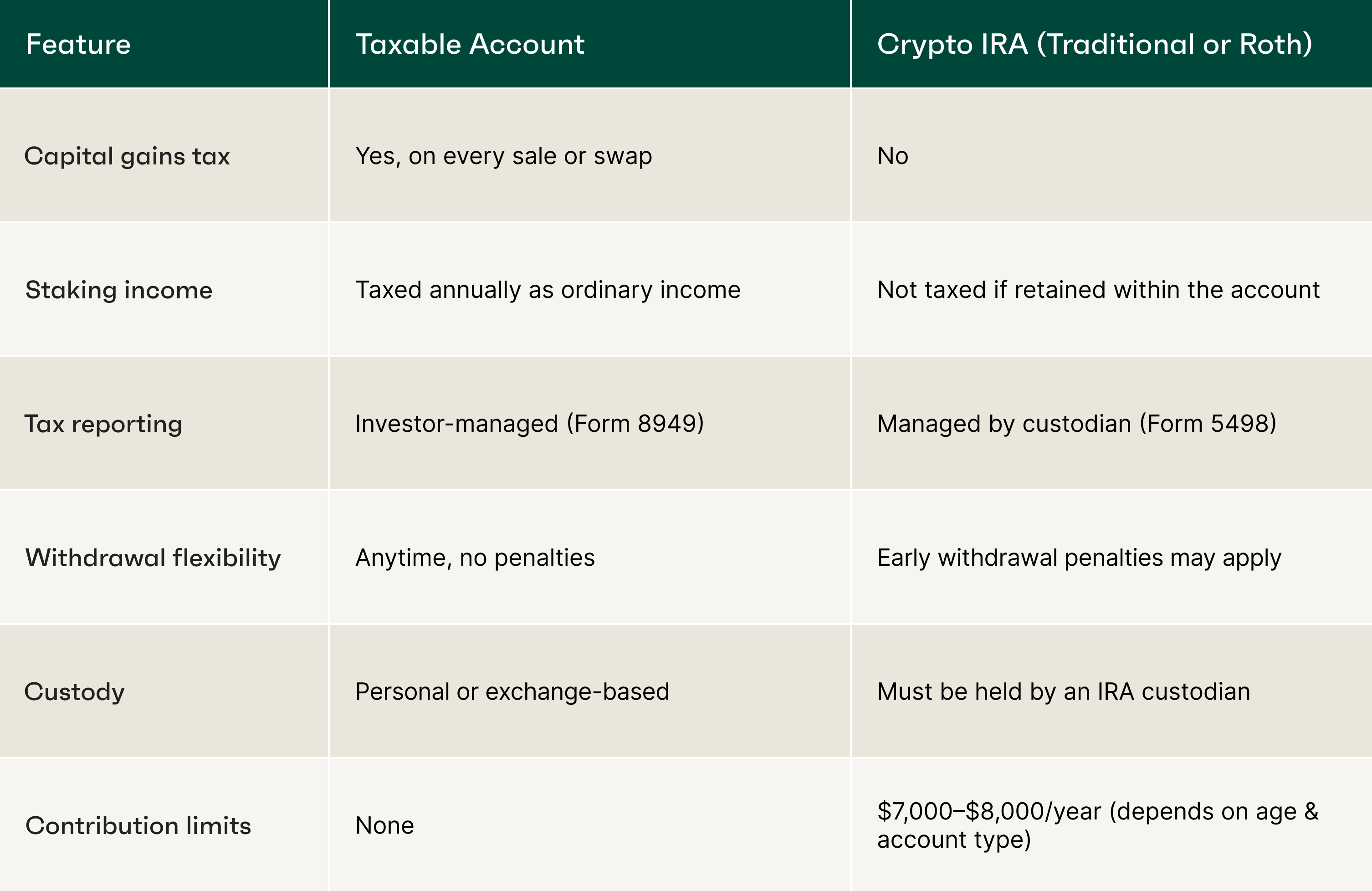As cryptocurrency becomes a more normalized part of investment portfolios, one key question continues to surface: should it be held in a taxable account or a tax-advantaged retirement account like an IRA?
The answer depends on long-term goals, trading behavior, tax strategy, and the investor’s preferred level of oversight and compliance.
This blog compares crypto IRAs and taxable accounts to help investors understand where to hold crypto in 2025.
How crypto is taxed in a standard taxable account
Cryptocurrency held in a taxable account is subject to IRS rules for property taxation. Each time a digital asset is sold, exchanged, or spent, a taxable event is triggered, even if profits are not withdrawn into fiat.
Common taxable events include:
- Selling crypto for fiat
- Trading one crypto for another
- Using crypto to pay for goods or services
- Receiving crypto from staking, mining, or airdrops
Tax treatment:
- Short-term gains (held <1 year): taxed at ordinary income rates
- Long-term gains (held ≥1 year): taxed at 0%, 15%, or 20%, depending on income
- Staking and mining rewards: taxed as ordinary income at the time of receipt
Note: Every transaction must be reported, and cost basis must be tracked manually or via software.
Given these conditions, high-frequency traders or long-term holders with large unrealized gains may face complex reporting and tax drag.
Let’s contrast this with what changes when the same crypto is held within an IRA.
How crypto is treated in an IRA
When digital assets are held in a self-directed IRA, they benefit from the same tax-advantaged treatment as traditional investments like stocks or bonds—either tax-deferred or tax-free, depending on account type.
Tax impact inside a crypto IRA:
- No capital gains tax on trades within the account
- No income tax on staking rewards (if retained within the account)
- Tax-deferred withdrawals for Traditional IRAs
- Tax-free qualified withdrawals for Roth IRAs
Note: Assets in a crypto IRA must be held by a qualified custodian. Personal custody is not allowed under IRS rules.
This structure eliminates ongoing tax liabilities and simplifies record-keeping, especially valuable for long-term holders or frequent rebalancers.
The difference in tax exposure alone can compound significantly over time.
Comparing crypto IRAs vs taxable accounts in 2025

Note: Roth IRAs offer tax-free growth, but contributions are not tax-deductible. Traditional IRAs are tax-deductible but taxed at withdrawal. See more detail on Roth vs. traditional crypto IRAs here.
Next, let’s look at the scenarios in which each account type may make more sense.
When to consider a taxable account for crypto
A taxable account may be a better fit in situations where:
- The investor needs flexible access to crypto at any time
- There's a desire to self-custody assets or interact directly with DeFi and NFTs
- The investor plans to use crypto for short-term trading or spending
- There's a strategy to harvest capital losses for tax offsets
Note: Some crypto use cases, such as DeFi, lending, and NFT trading, are often unsupported in IRAs due to IRS restrictions or custodian policies.
For maximum flexibility and freedom, a taxable account remains the most open-ended option, but it comes with trade-offs in tax complexity.
Now consider when a crypto IRA offers an alternative path.
When a crypto IRA offers more strategic value
A crypto IRA may be better suited when:
- The goal is long-term retirement growth, not short-term spending
- The investor seeks to minimize annual tax obligations from trading or staking
- There is existing retirement capital to roll over from a 401(k) or IRA
- The plan is to hold crypto for decades, without triggering taxable events
Note: Crypto IRAs do have limitations—early withdrawals before age 59½ can incur taxes and penalties unless exceptions apply.
However, for long-term investors who view crypto as a generational asset or part of a retirement allocation, the tax-deferred or tax-free compounding is difficult to match.
Strategic allocation approaches for CryptoIRA
Rather than choosing exclusively between account types, many investors benefit from strategic allocation across both structures:
Hybrid allocation strategies:
- Core holdings in IRAs: Stable, long-term cryptocurrency positions benefit from tax deferral
- Tactical positions in taxable accounts: Short-term trading and tax-loss harvesting opportunities
- Age-based shifting: Gradually moving holdings toward more accessible structures approaching retirement
- Asset-specific placement: Higher-growth potential assets in Roth IRAs, stable assets in taxable accounts
These approaches attempt to optimize the benefits of each structure while minimizing respective disadvantages.
Note: Coordination across multiple account types requires careful planning to maintain desired overall allocation percentages.
Implementation through Alto CryptoIRA® provides specific advantages for retirement-focused strategies.
Learn about Alto CryptoIRA here.
Disclaimer: This information is educational only and not investment or tax advice. Investors should consult qualified financial and tax professionals regarding their specific situations before making account structure decisions.





